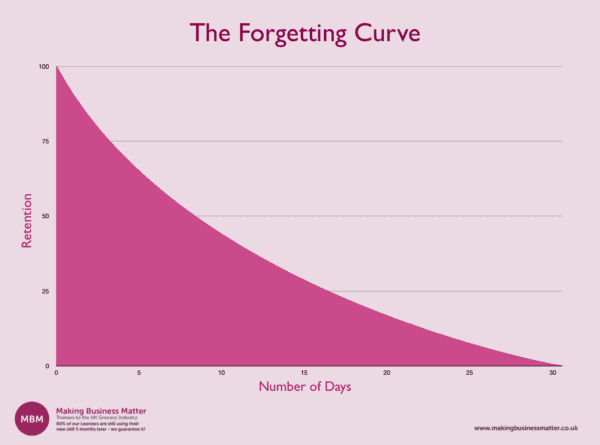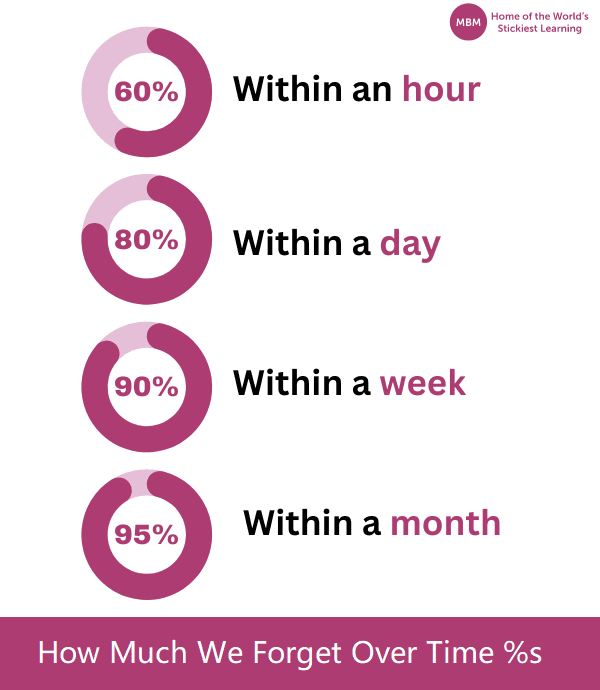Why did you forget nearly everything you learnt on your last training course? Ebbinghaus’s Forgetting Curve has the answer.
The answer is simple. You didn’t use it. Let me explain why by going right back to the 1880s and the Forgetting Curve.
A German psychologist called Hermann Ebbinghaus experimented with his memory. Now, this is over 175 years ago and his work then is still relevant today.
His work that coined the phrase ‘The Forgetting Curve’ and ‘Spacing effect’ was groundbreaking for then, and even more now, considering what we know about the brain. But that’s not the amazing thing. What’s amazing is that we still aren’t listening…
What Are We Not Listening to?
Hermann’s experiment was simple. He used 2,300 nonsense words, as he called them. They had no particular meaning and were a test of memory as they had no meaning.
For example, the words were ‘DAX’, ‘BOK’, and ‘YAT.’ Each word was written on a postcard. He would then pull out random cards, write them down and once he had pulled out a bunch, he would then try to recall them. Wikipedia reports that one investigation alone required 15,000 recitations.
Hermann discovered what we instinctively know – our memory weakens over time. In other words, we forget over time.

In 2015 Prof. Dr J.M.J. (Jaap) Murre, from the Faculty of Social and Behavioural Sciences Programme group Brain and Cognition at the University of Amsterdam, re-did the experiment and published his report. He concluded the same thing – we forget over time.
We exchanged emails with Professor Murre and asked him what he wanted people to understand from his research. He told us these 3 things:
- There are very large individual differences in learning and forgetting and within one individual they are material dependent (e.g. words versus numbers).
- When learning really difficult material, you often don’t see any progress for quite a while, or very little, but internally learning progresses just fine.
- The first night of sleep after learning seems to counteract forgetting to some extent.
Professor Murre replied to our question, ‘How much do we forget?’ His reply was:
You cannot really answer this question as it is very much dependent on the material (easy versus hard, simple versus complex, how much background do you already have), how long you have studied the material (2 s or 2 min or much longer), how good your memory is (age is also a factor), etc.
It is a bit like asking: How fast does an animal run? or How fast does a car accelerate? This is also the reason why, say, the Ebbinghaus forgetting curve is not ‘The Forgetting Curve’ as many people think. It is just an example of a very well conducted experiment that gave a good idea of a particular forgetting curve for a particular (probably highly intelligent) man. With different materials (e.g., words or phrases) and a different measure of memory (e.g., recognition) different curves will be found.
Our Conclusion of the Research
Whilst the numbers are not absolute because it depends on many factors, such as what you are learning, broadly we forget over time. Our guidance for how much we forget is as follows:

One-Minute Video on the Forgetting Curve
In this one-minute video, I explain Ebbinghaus’ work a little more:

On a recent visit to the South Coast of the United Kingdom, I noticed that Hermann Ebbinghaus lived in Sleaford for a time. A wonderful coincidence!

Bad Return on Investment from Training
We went to school for many years and, well, I had double English every Thursday afternoon. I hated it. But it was repetition, with space in between, and homework to embed the learning. Then, we leave school and join the corporate world. Suddenly, we don’t need repetition, or embedding because, in a 1-day training course, we can learn all that we need about a skill – Untrue! We cannot, as we have all proven time and time again because of the training courses you attended, you have forgotten. One-day training courses do not change behaviours.
The best learning we have had was at school and also when we learnt to drive because it embodied the very essence of what was discovered in the 1800s. We need repetition, space between, and to use what we learnt. Any other way of learning is a waste of time.
My concern is that millions if not billions of pounds are being flushed down the toilet on training because one-day training courses do not transfer the learning to the Learners. They simply impart information, which the Learner separately tries to receive, but ultimately the biggest drop in retention happens straight after the learning.
So, we learnt more than a century ago that how we train people will not work. We need to change what we do. There is good news because we can enable people to change their behaviours. We need to rewire how training/learning is done, and go back to the principles that changed our behaviours; school and driving.
Sticky Learning Principles Embed The Forgetting Curve
Sticky learning is about letting science lead us. Letting our instincts guide us. Living the following principles:
- Stop 1-day training courses because they achieve diddly squat. Blended programs only; virtual, face-to-face, and offline.
- Have spaces between learnings. Just like when you learnt to drive – a lesson each week. In Ebbinghaus’s published research, available on Wiki, called ‘über das gedächtnis’ (About memory), states in chapter 8:
It makes the assumption probable that with any considerable number of repetitions a suitable distribution of them over a space of time is decidedly more advantageous than the massing of them at a single time.
- Provide sticky pieces (homework) because the Learner needs to use what they have learnt straight away.
As a mnemonic, the above would be R.S.U:
- Repetition
- Space
- Use
Our method of training is light on Powerpoint, and sometimes no slides at all. It is heavy on the Learner capturing their thoughts using ‘Keepers’, and lots of embedding. Plus, less content until it becomes behavioural, rather than lots of content that are never used.
Find out how you can listen to Hermann’s forgetting curve with Sticky Learning – Click on the image below:





